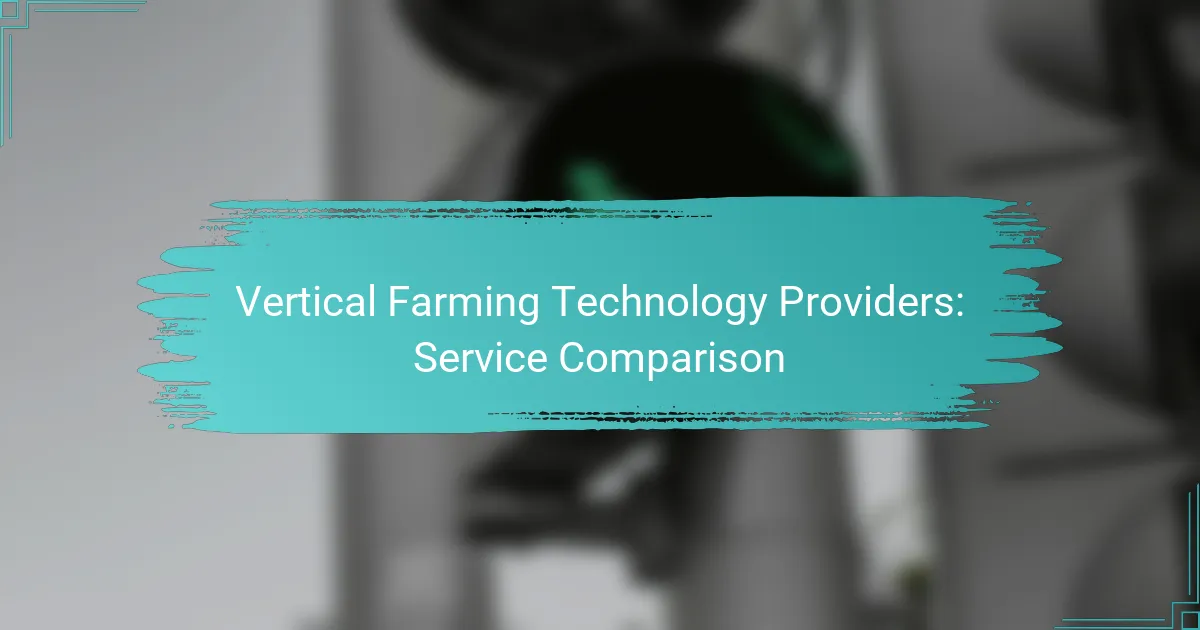Vertical farming technology providers play a crucial role in advancing sustainable agriculture by offering innovative solutions for crop production in controlled environments. Companies like AeroFarms, Plenty, and Bowery Farming each bring unique technologies and services that can significantly influence efficiency, crop yield, and operational costs. Understanding the differences in their offerings, including growing systems and pricing models, is essential for selecting the right partner in this rapidly evolving industry.
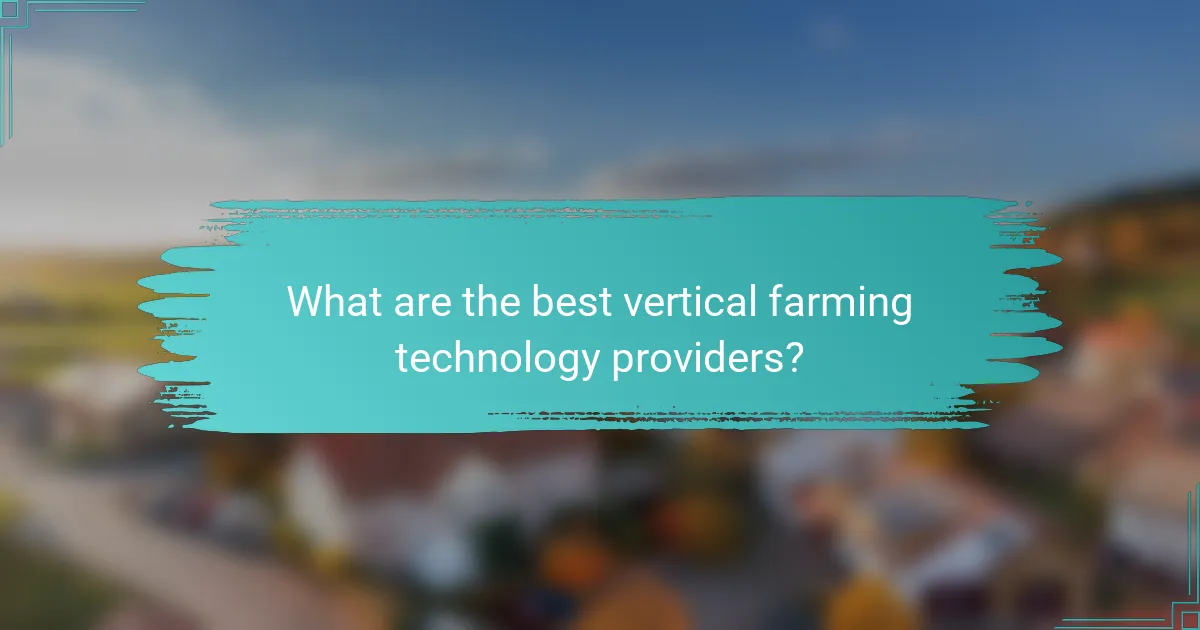
What are the best vertical farming technology providers?
The best vertical farming technology providers are companies that offer innovative solutions for growing crops in controlled environments. Key players in this sector include AeroFarms, Plenty, Vertical Harvest, Bowery Farming, and Green Spirit Farms, each with unique technologies and approaches to sustainable agriculture.
AeroFarms
AeroFarms is known for its aeroponic growing system, which uses mist to deliver nutrients directly to plant roots. This method significantly reduces water usage compared to traditional farming, making it an eco-friendly option.
With facilities primarily located in the United States, AeroFarms focuses on leafy greens and herbs, providing fresh produce to local markets. Their technology allows for year-round cultivation, ensuring consistent supply regardless of seasonal changes.
Plenty
Plenty utilizes a combination of vertical farming and advanced robotics to optimize space and enhance crop yields. Their farms are designed to grow a variety of produce, including lettuce and strawberries, with minimal environmental impact.
Based in the U.S., Plenty’s systems are equipped with sensors and machine learning algorithms that monitor plant health and growth conditions, allowing for precise adjustments. This technology can lead to higher quality produce with reduced pesticide use.
Vertical Harvest
Vertical Harvest specializes in urban vertical farming, focusing on producing fresh vegetables and herbs in city environments. Their model integrates local food production with community engagement, providing job opportunities for individuals with disabilities.
Located in Jackson, Wyoming, Vertical Harvest operates a three-story greenhouse that maximizes space and energy efficiency. Their commitment to sustainability includes using renewable energy sources and minimizing waste.
Bowery Farming
Bowery Farming employs a fully controlled indoor farming system that leverages technology to grow crops without pesticides. Their farms utilize LED lighting and a proprietary growing platform to optimize plant growth.
With operations in the U.S., Bowery focuses on providing fresh, local produce to urban areas. Their approach emphasizes transparency and sustainability, allowing consumers to trace the origin of their food easily.
Green Spirit Farms
Green Spirit Farms is dedicated to sustainable agriculture through vertical farming techniques that reduce land use and water consumption. They grow a variety of crops, including herbs and microgreens, using hydroponics and aquaponics.
Operating in the U.S., Green Spirit Farms aims to supply fresh produce to local communities while minimizing their carbon footprint. Their systems are designed for scalability, making them suitable for both small and large operations.
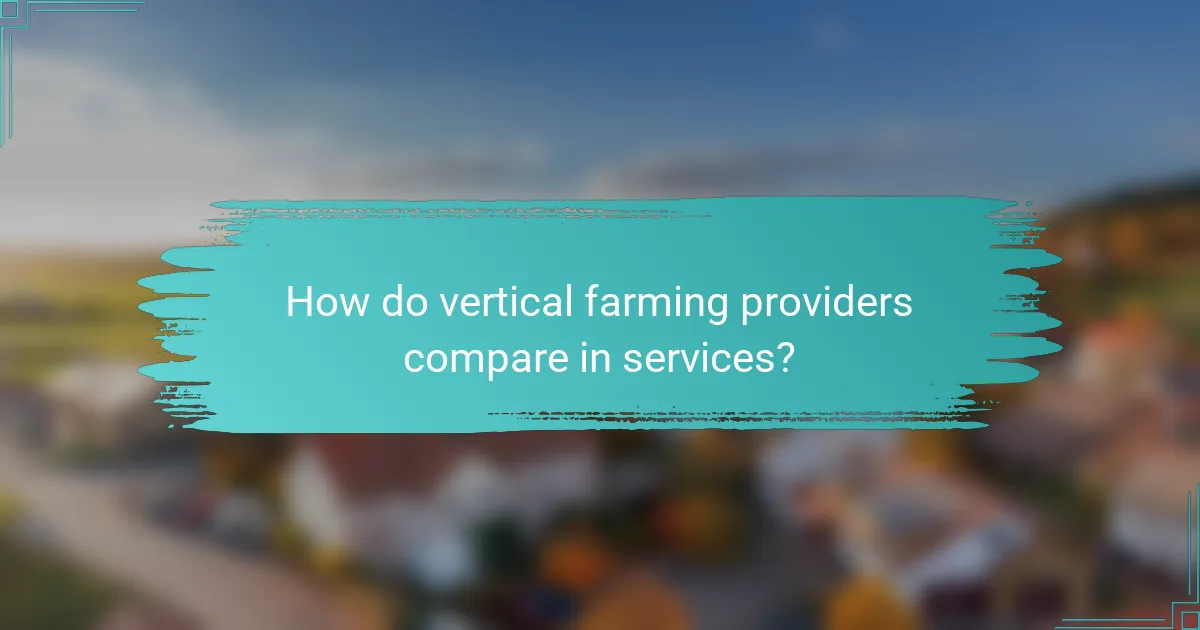
How do vertical farming providers compare in services?
Vertical farming providers differ significantly in the services they offer, impacting efficiency, crop yield, and operational costs. Key factors include the type of growing systems they utilize, the level of technology integration, and the variety of crops they can produce.
Hydroponics vs. Aeroponics
Hydroponics and aeroponics are two primary growing methods used in vertical farming. Hydroponics involves growing plants in nutrient-rich water, while aeroponics suspends plants in air and mists their roots with nutrients. Each method has its advantages; hydroponics is often easier to manage, while aeroponics can lead to faster growth rates and reduced water usage.
When choosing between these systems, consider factors such as initial setup costs, maintenance requirements, and the specific crops you aim to grow. Hydroponic systems may require more space and water, while aeroponic systems can be more compact and efficient but may need more precise monitoring.
Technology integration
Technology integration in vertical farming can include automation, data analytics, and climate control systems. Providers that offer advanced technology can enhance operational efficiency, reduce labor costs, and improve crop monitoring. For instance, automated systems can manage watering and nutrient delivery, while sensors can track plant health and environmental conditions.
Evaluate the level of technology integration based on your operational needs and budget. Some providers may offer fully automated solutions, while others might provide basic systems that require more manual intervention. Consider the long-term benefits of investing in more advanced technology against the initial costs.
Crop variety offered
The variety of crops offered by vertical farming providers can vary widely, influencing your choice based on market demand and profitability. Some providers specialize in leafy greens, herbs, and microgreens, while others may offer a broader range that includes fruits and vegetables. Understanding the crop variety is essential for aligning with consumer preferences and maximizing returns.
When assessing providers, consider their ability to grow high-demand crops and their flexibility to adapt to new varieties. Additionally, check if they have experience with specific crops that are popular in your region, as local market trends can significantly impact success.
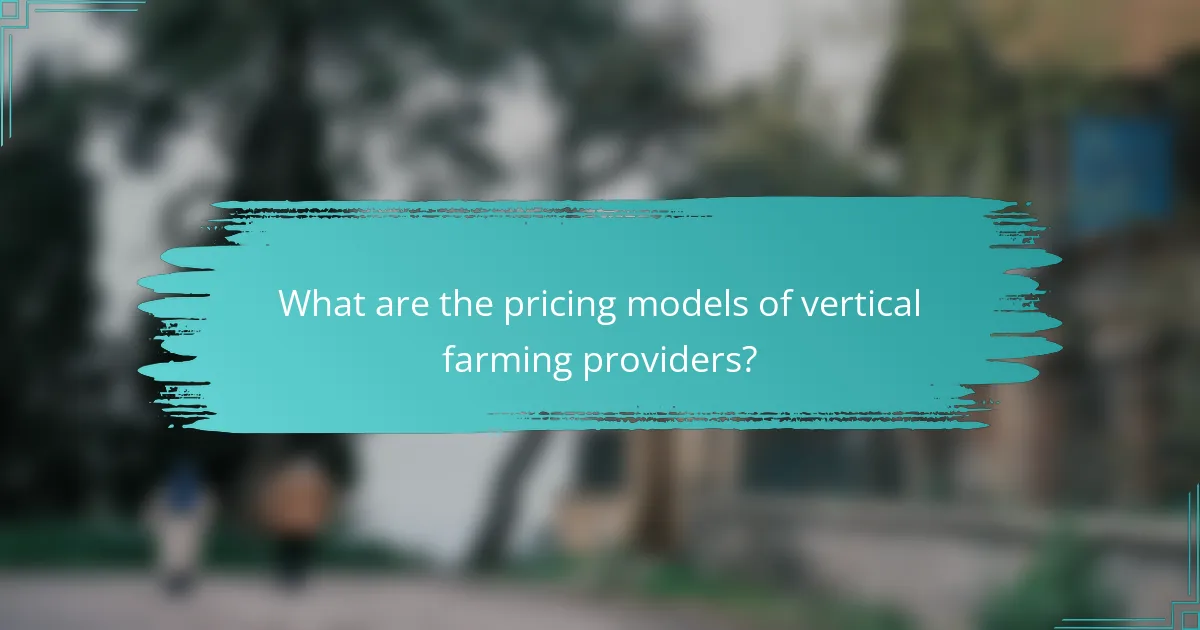
What are the pricing models of vertical farming providers?
Vertical farming providers typically offer various pricing models, including subscription-based pricing, one-time purchase models, and lease agreements. Each model has distinct advantages and considerations that can affect the overall cost and operational flexibility for users.
Subscription-based pricing
Subscription-based pricing allows customers to pay a recurring fee, often monthly or annually, for access to vertical farming systems and services. This model can include maintenance, software updates, and support, making it a convenient option for those who prefer predictable costs.
Many providers offer tiered subscription plans based on the scale of the operation, which can range from small home setups to larger commercial systems. This flexibility enables users to select a plan that aligns with their budget and production goals.
One-time purchase models
One-time purchase models involve a single upfront payment for the vertical farming equipment and technology. This option is suitable for businesses that prefer to own their systems outright without ongoing fees.
While the initial cost can be significant, typically ranging from several thousand to tens of thousands of dollars depending on the complexity and size of the system, it eliminates future subscription costs. However, users should consider potential maintenance and operational expenses that may arise over time.
Lease agreements
Lease agreements provide an alternative to outright purchases, allowing users to rent vertical farming systems for a specified period. This model can be beneficial for startups or businesses testing the market without committing to a large capital investment.
Leasing terms can vary widely, often spanning from one to five years, and may include options for purchasing the equipment at the end of the lease. This flexibility can help businesses manage cash flow while still accessing advanced farming technology.
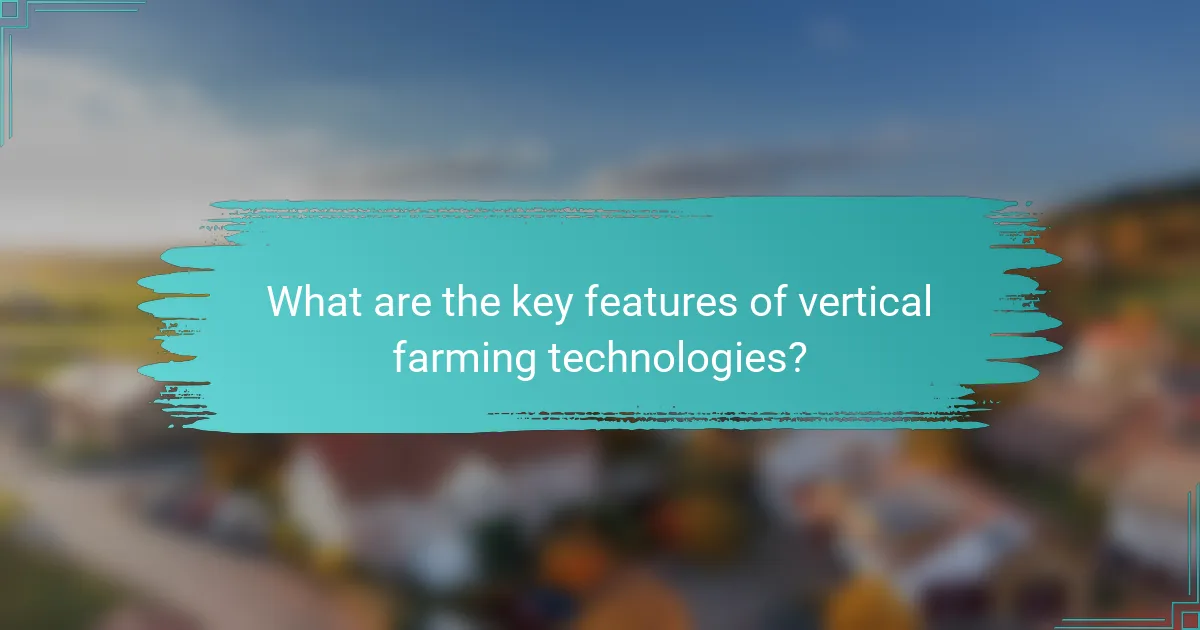
What are the key features of vertical farming technologies?
Vertical farming technologies are characterized by their ability to grow crops in stacked layers, utilizing controlled environments to optimize growth conditions. Key features include energy efficiency, automated systems, and scalability options that cater to various operational needs.
Energy efficiency
Energy efficiency in vertical farming is crucial as it directly impacts operational costs and sustainability. Many systems utilize LED lighting, which consumes significantly less energy compared to traditional lighting methods, often reducing energy use by up to 50%.
Additionally, advanced climate control systems help to minimize energy waste by optimizing heating, cooling, and ventilation. When selecting a vertical farming provider, consider their energy consumption metrics and any renewable energy options they may offer.
Automated systems
Automated systems in vertical farming streamline operations and enhance productivity. These systems can include automated irrigation, nutrient delivery, and environmental monitoring, allowing for precise control over growing conditions.
Investing in automation can lead to labor cost savings and consistent crop quality. However, it’s essential to evaluate the reliability of these systems and the level of technical support provided by the technology provider.
Scalability options
Scalability options are vital for vertical farming businesses looking to expand. Many technology providers offer modular systems that can be easily scaled up or down based on demand, allowing operators to adjust their production capacity without significant upfront investments.
When assessing scalability, consider the initial setup costs versus long-term growth potential. Look for providers that offer flexible solutions, enabling you to start small and expand as your market grows.
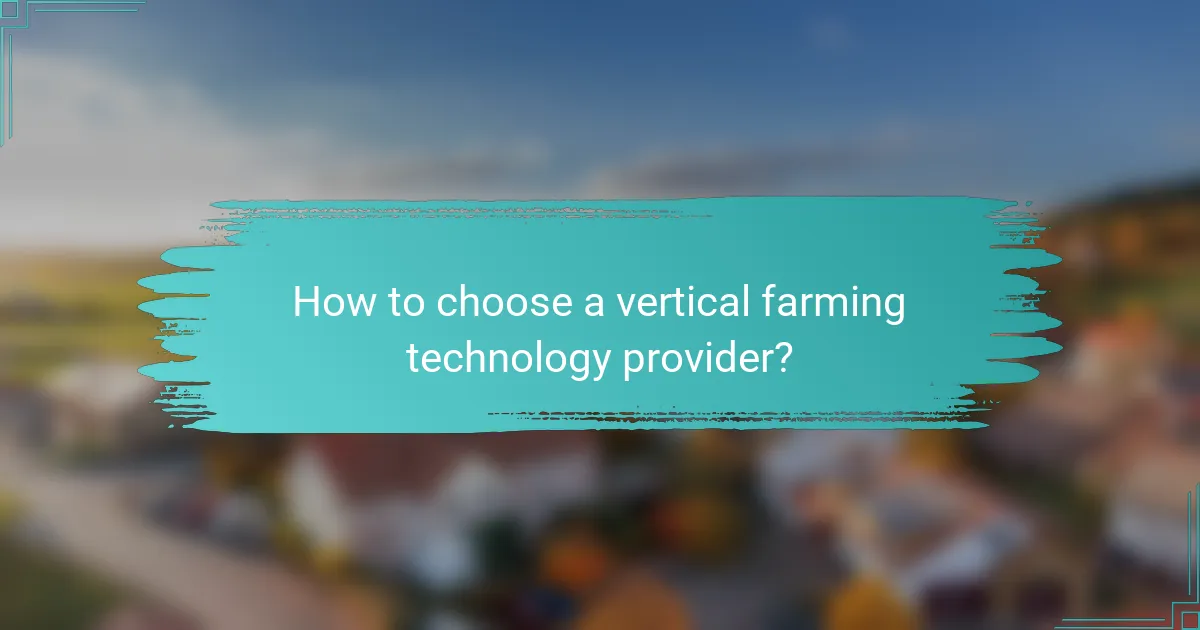
How to choose a vertical farming technology provider?
Choosing a vertical farming technology provider involves evaluating their offerings against your specific operational needs and market conditions. Focus on compatibility with your existing systems, support services, and how well they address local market demands.
Assessing local market needs
Understanding local market needs is crucial for selecting a vertical farming technology provider. Consider factors such as consumer preferences, local crop suitability, and regional regulations that may influence your farming operations.
For example, if your market favors organic produce, ensure the provider’s technology supports organic farming practices. Additionally, assess the competition in your area to identify gaps that your vertical farm can fill.
Evaluating technology compatibility
Technology compatibility is essential for seamless integration into your existing operations. Assess whether the provider’s systems can work with your current infrastructure, including software and hardware.
Look for providers that offer scalable solutions, allowing you to expand or modify your setup as your business grows. It’s also beneficial to check for compatibility with automation tools and data analytics platforms to enhance efficiency.
Understanding customer support
Reliable customer support can significantly impact your vertical farming success. Evaluate the level of support offered by the provider, including training, troubleshooting, and maintenance services.
Consider providers that offer 24/7 support or local service teams to minimize downtime. Reading customer reviews and testimonials can provide insights into the quality of their support and responsiveness to issues that may arise.
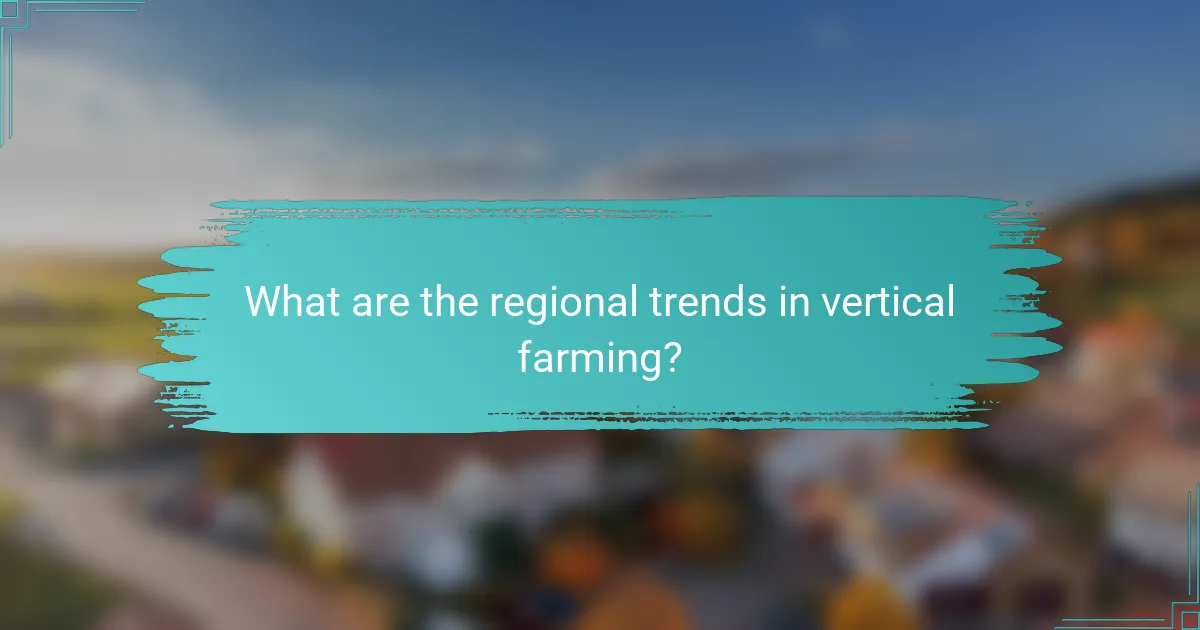
What are the regional trends in vertical farming?
Regional trends in vertical farming reflect varying consumer demands, technological advancements, and local agricultural practices. Key areas of growth include North America, Europe, and Asia, each adapting vertical farming to meet specific market needs and environmental conditions.
North America
In North America, vertical farming is gaining traction due to increasing urbanization and a growing demand for locally sourced produce. Companies are leveraging advanced technologies such as hydroponics and aeroponics to maximize yield in limited spaces. The market is supported by significant investments and a focus on sustainability, with many farms aiming for zero waste and reduced carbon footprints.
Key players in this region often collaborate with tech firms to enhance automation and data analytics, improving operational efficiency. For instance, some farms utilize AI-driven systems to monitor plant health and optimize resource usage, which can lead to cost savings and higher productivity.
Europe
Europe’s vertical farming landscape is characterized by a strong emphasis on sustainability and regulatory compliance. Many countries are implementing policies that support urban agriculture, making it easier for vertical farms to operate within city limits. The European market is also seeing a rise in consumer interest in organic and pesticide-free produce, pushing farms to adopt environmentally friendly practices.
Vertical farms in Europe often focus on high-value crops like herbs and leafy greens, which can be produced efficiently in controlled environments. Collaboration among startups and established agricultural companies is common, fostering innovation and knowledge sharing across the industry.
Asia
Asia is witnessing rapid growth in vertical farming, driven by high population density and food security concerns. Countries like Japan and Singapore are leading the charge, implementing vertical farming solutions to supplement traditional agriculture. These farms often utilize cutting-edge technology, including LED lighting and climate control systems, to optimize growth conditions.
Investment in vertical farming in Asia is substantial, with government initiatives supporting research and development. The focus is not only on increasing food production but also on addressing environmental challenges, such as land scarcity and water shortages, making vertical farming a viable solution for urban areas.
